Sansad TV and AIR Summary
March 2nd Week
Agni-5 missile with MIRV technology
Context
The Defence Research and Development Organisation (DRDO) conducted the first flight test of the indigenously produced Agni-5 missile, which is a part of ‘Mission Divyastra’. The flight test named Mission Divyastra was carried out from Dr APJ Abdul Kalam Island in Odisha.
|
This weapon is equipped with Multiple Independently Targetable Re-entry Vehicle (MIRV) technology that boosts its effectiveness in delivering multiple warheads to different targets with precision. At present, the US, UK, France, China, Russia and India are among the elite group that possesses the technology.
|
About Agni-5
- Agni is a long-range missile developed indigenously by the Defence Research and Development Organisation, DRDO.
- The missile is being inducted into the Strategic Forces Command (SFC).
- It uses a three-stage solid-fueled engine and is capable of striking targets at ranges up to 5,000km with a very high degree of accuracy.
- The Agni series of ballistic missiles and warplanes such as Rafales, Sukhoi-30s and Mirage-2000s can deliver nuclear warheads.
- India is also developing a new class of ultra-modern weapons that can travel six times faster than the speed of sound (Mach 6) and penetrate any missile defence.
Agni Missiles Family
|
Agni I: Short-range ballistic missile
|
Range more than 700 km
|
|
Agni II: Medium-range ballistic missile
|
Range more than 2000 to 3500 km
|
|
Agni III: Intermediate-range ballistic missile
|
Range more than 3000 km
|
|
Agni IV: Intermediate-range ballistic missile
|
Range more than 3500 km
|
|
Agni-Prime: A nuclear-capable, two-stage canisterised solid propellant ballistic missile
|
Range 1,000 to 2,000 km
|
Agni upgrade
- The integration of MIRV technology is a long-awaited upgrade for the Agni family of short, medium and intercontinental-range ballistic missiles indigenously developed by the DRDO.
- Agni missiles are the main land-based delivery systems for India’s nuclear weapons.
- Agni-1 to Agni-IV missiles have ranges between 700 to 3,500 km and can carry single payloads weighing between 12 and 40 kilotons.
- Agni-5, the version that has been equipped with MIRV technology, can travel more than 5,000 km, and can potentially enter the intercontinental range as well, considered to be 5,500 km and above.
- The next generation Agni-6 missile, currently under development, is also expected to be equipped with MIRV.
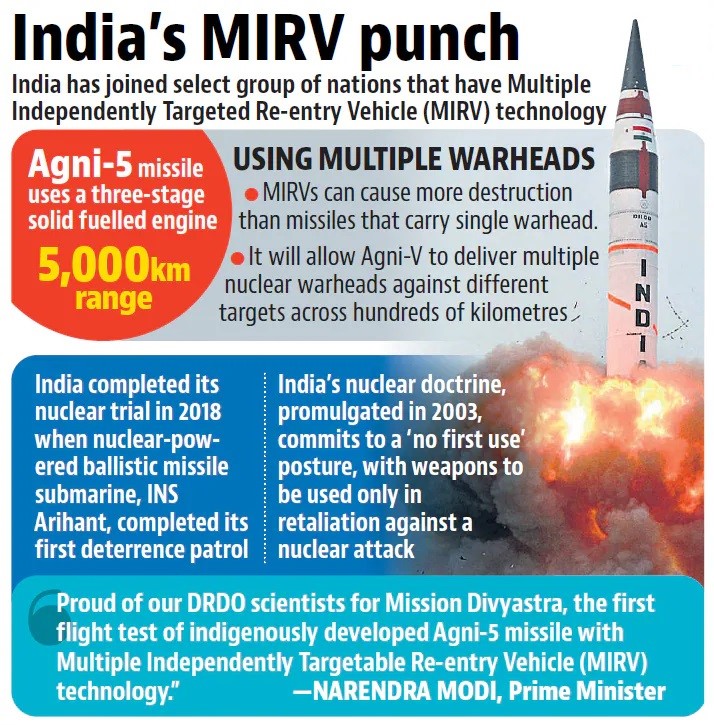
Copyright infringement is disclaimed
About MIRV technology
- Multiple independently targetable Reentry Vehicles (MIRVs), developed first in the early 1960s, were designed to enable a missile to deliver multiple nuclear warheads to distinct targets.
- The MIRV has revolutionised the concept of ballistic missile payloads by enabling a single missile to carry multiple warheads, each capable of targeting enemies at different locations.
- The warheads on MIRVs can be launched at different speeds and in different directions.
- Warheads on missiles equipped with MIRVs can be deployed at varying speeds and directions, allowing for the targeting of locations up to 1,500 kilometres apart.
- The technology requires a delicate combination of large missiles, small warheads, precise guidance, and a complex mechanism for releasing warheads sequentially during flight.
Historical background of MIRV technology
- The technology was first introduced in the US with the successful test of the Minuteman III in 1968, which brought the technology into actual use in the 1970s.
- The Soviet Union developed their MIRV-enabled ICBM and SLBM technology by the end of the 1970s.
- The strategic shift started by MIRV has enabled many nations to greater target damage and reduce the effectiveness of enemy missile systems, altering the landscape of global nuclear deterrence.
Working of MIRV technology
- An MIRV-equipped missile follows a trajectory into space similar to other ballistic missiles.
- After the boost phase, the missile’s upper stage, known as ‘bus’, reaches suborbital spaceflight, and aligns itself based on designated targets.
- The ‘bus’ sequentially deploys multiple warheads along with decoys and countermeasures. Each warhead can be assigned a different target or trajectory.
- After the deployment, the warheads re-enter the Earth’s atmosphere and proceed to their respective targets.
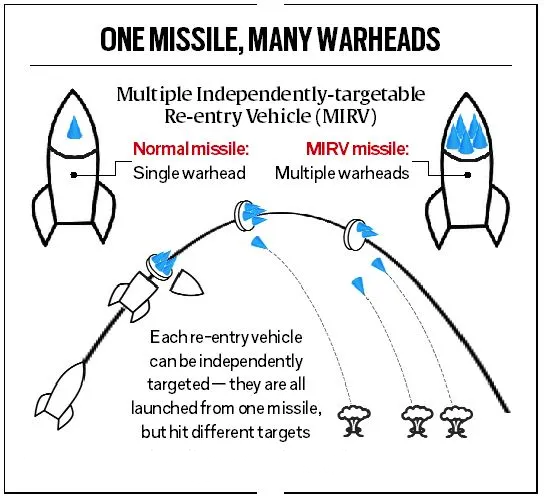
Significance
- It is the first flight test of an indigenously developed 6,000 km range nuclear missile Agni-5 missile with Multiple Independently Targetable Re-entry Vehicle (MIRV) technology.
- It means that a single missile by India can deploy multiple warheads at different locations or the same location with a time gap.
- These warheads could also include decoys to hoodwink the enemy’s ballistic missile defence programme.
- Another key strategic benefit, especially for countries like India which has a no-first use policy for nuclear weapons, is the capability to cause crippling damage in a response strike. The response strike could be disproportionate, and can thus serve as a deterrence to the enemy.
Advantages of MIRV technology
- Apart from the obvious advantage of inflicting multiple damages with a single strike, MIRV is a sought-after military technology for several other reasons.
- One of them is its ability to penetrate missile defence systems.
ICBM Zone
- Agni-V is classified as an inter-continental ballistic missile (ICBM), having a range of 5,500 km or more. The US, Russia, China, France and Israel already possess such missiles.
Indian Ballistic Missile Defence Programme (IBMD)
- The Indian Ballistic Missile Defence Program is an initiative to develop and deploy a multi-layered ballistic missile defence system to protect India from ballistic missile attacks.
- It was launched in 2000 after the Kargil War by former Prime Minister Atal Bihari Vajpayee.
- It was introduced in light of the ballistic missile threat from Pakistan and China.
- It is a double-tiered system consisting of two land and sea-based interceptor missiles, namely the Prithvi Air Defence (PAD) missile for high-altitude interception, and the Advanced Air Defence (AAD) Missile for lower-altitude interception.
Challenges
- The MIRV technology enhances first-strike proficiency and complicates the calculus of mutually assured destruction.
- With the ability to deploy multiple warheads from a single missile, nations can achieve a broader spread of targets, making the defence system less effective and more costly.
- Although MIRVs were not initially made to defeat ballistic missile defences, they are much more difficult to defend against than traditional missiles.
Way forward
- The development of MIRV capability marks a significant upgrade for India’s missile systems, and expands its nuclear options.
- Agni-5 missiles have a range of up to 5,000 km and it can bring almost the entire Asia including the northernmost part of China as well as some regions in Europe under its striking range.
- It will greatly enhance India's national security delivering multiple warheads to different targets with precision.
- Possession of MIRV technology not only exhibits a country’s nuclear prowess but plays a crucial role in shaping international security and nuclear deterrence strategies.
Joint Economic and Trade Committee between India and Dominican Republic
Context
The Union Cabinet had approved the proposal for the signing Joint Economic and Trade Committee (JETCO) between India and the Dominican Republic. The protocol signifies a crucial step in strengthening the economic and commercial ties between the two nations.
|
The Joint Economic and Trade Committee (JETCO) agreement, signed 25 years after the establishment of diplomatic relations between the two countries, is an important step to elevate the existing economic and commercial relations further.
|
Objective
- The agreement aims to foster cooperation across various sectors, including trade, services, and industrial technologies.
- The protocol seeks to address industry challenges through:
- Technical assistance
- Training programs
- Capacity-building
- The initiatives facilitate knowledge sharing and adopting best practices.
- The joint committee will provide a platform for information exchange between various authorities and their counterparts.
|
The protocol can be an effective gateway to the larger Latin American and Caribbean markets. The Dominican Republic is the third largest provider of pharmaceutical and medical devices in Latin America.
|
Bilateral trade
- The bilateral trade between the countries has dipped to $690 million in 2022-23 from $959 million in 2021-22.
- The trade balance is in the favour of the Dominican Republic.
- India exported goods to the tune of $278.35 million in the first 10 months of this fiscal.
- India exports engineering goods, drugs, pharmaceuticals, ceramic products, glassware, marine products, cotton yarn, handloom products, organic and inorganic chemicals, tobacco, electronic goods, fruits and vegetables, etc
- India imports gold from the Dominican Republic and exports pharmaceuticals, marine products, motor vehicles, and two- and three-wheelers, among other goods.
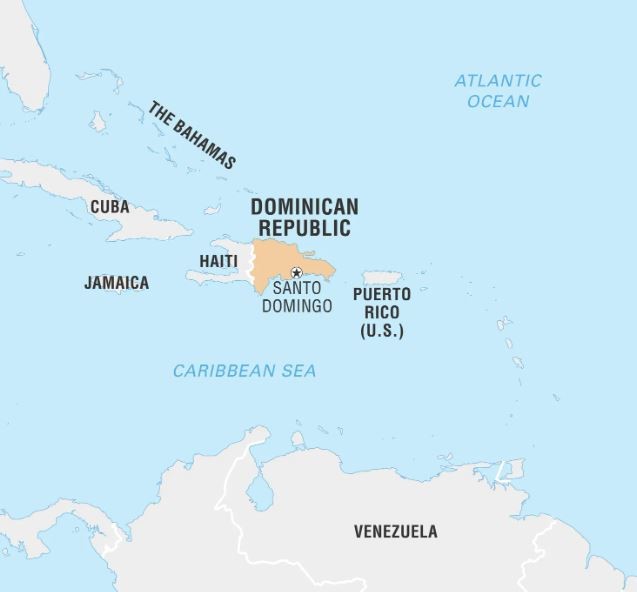
Copyright infringement is disclaimed
Prospects in the Dominican Market
Pharmaceuticals: The Dominican Republic is a good market for our Pharma products. Indian companies doing business in the country could combine their business operations with Haiti (the two countries form the island of Hispaniola)
Information Technology: The Dominican Republic aspires to become the IT hub of the Caribbean. It is looking for Indian partners who could provide service to the US and to Latin America. IT friendly policies of the government along with English and Spanish speaking trained manpower could be leveraged to start ITES /BPO units
Tourism: The DR attracts more than 4 million tourists. Indian hotels could look into the opportunities for investing in hotel resorts and real estates.
Mining: DR has substantial reserves of Nickel and Gold
Renewable Energy: Indian companies could market their products to the DR which is looking to diversify its energy supplies.
Film Industry: Indian film makers looking for exotic locations could explore the DR. Support and technical services would be much cheaper than locales in Europe.
DR-CAFTA free trade agreement: The implementation of DR- CAFTA pact has opened up opportunities for Indian companies which could setup operations in the DR for the US market.
Dominican Republic: Facts
|
Capital
|
Santo Domingo
|
|
Area
|
48,442 sq km
|
|
Population
|
10.7 million
|
|
Language
|
Spanish
|
Way forward
- The establishment of JETCO will facilitate mitigating challenges in the export of Indian products and will pave the way for boosting exports and more foreign exchange earnings for a Atmanirbhar Bharat.
- The Joint Committee will provide a platform for the exchange of information between various authorities and their counterparts.
- This would help in facilitating trade of goods and services and consequentially help in better employment opportunities for professionals in both countries.
Bharat Mobility Global Expo 2025
Context
The union government has announced the dates for the next edition of the Bharat Mobility Global Expo 2025 following the success of the inaugural event, the 2025 edition will be held at three venues simultaneously.
Key Points
- Bharat Mobility Global Expo 2025 will exhibit a diverse range of commercial and passenger vehicles, electric vehicles (EVs), auto components, tyres, battery and storage components, software integrated into vehicles, and construction equipment, among others.
- The event will be industry-led with active participation from Industry associations such as EEPC India, SIAM, ACMA, ATMA, IESA, NASSCOM, ICEMA, Invest India, CII, FICCI, and ASSOCHAM.
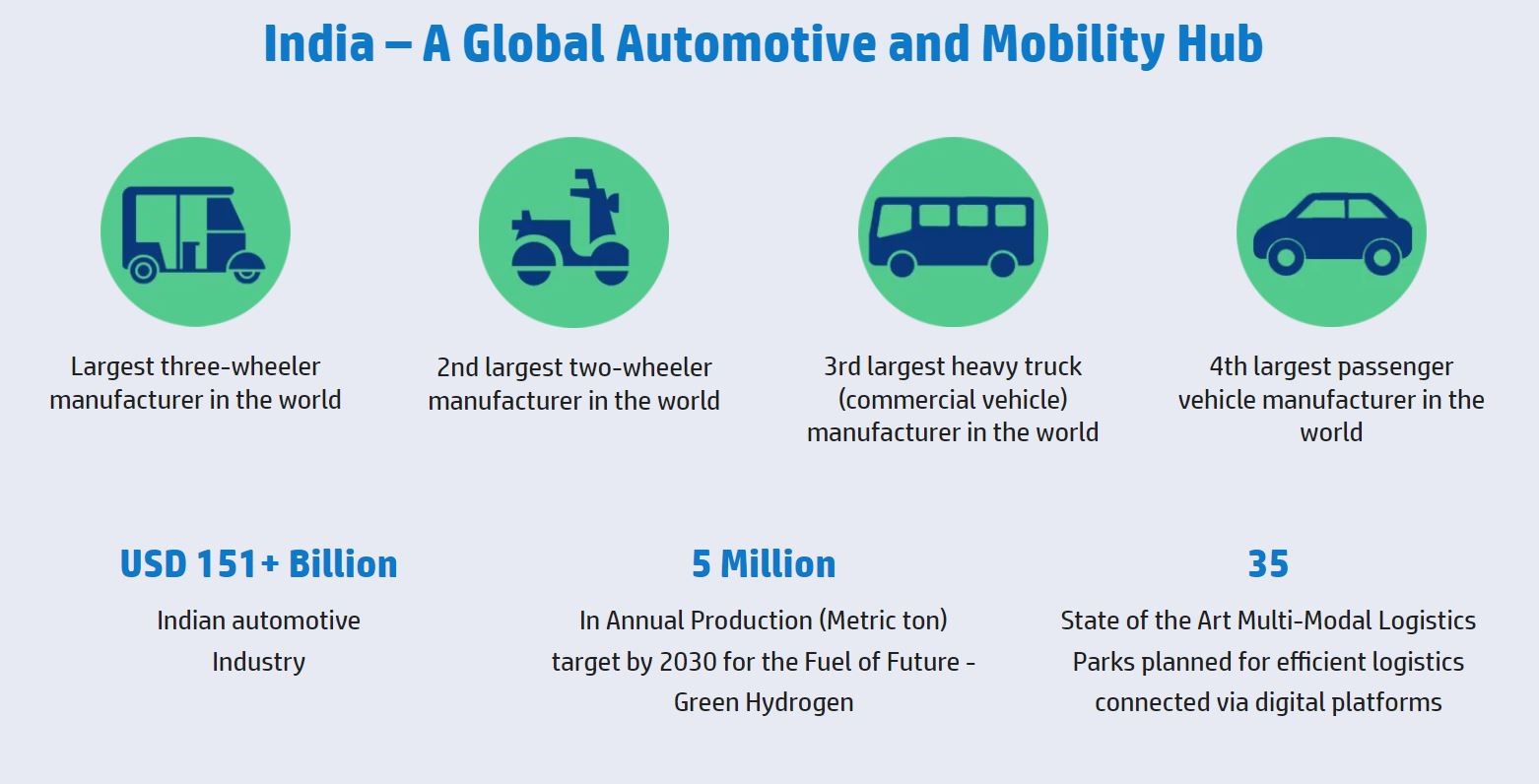
Copyright infringement is disclaimed
India’s Automobile market
- The Automobile industry produced a total 22.93 Mn vehicles including Passenger Vehicles, Commercial Vehicles, Three Wheelers, Two Wheelers, and Quadricycles in Apr 2021 to Mar 2022.
- Automobile Sector resulted in 5.41% of the total FDI inflow as per the Sept 2023 DPIIT Report.
- The EV market is expected to grow at CAGR of 49% between 2022-2030 and the EV industry would create 5 Mn direct and indirect jobs by 2030.
- India aims to double its auto industry size to INR 15 Lakh Cr by end of year 2024.
- In the Automobile market in India, Two-wheelers and passenger cars accounted for 76% and 17.4% market share, respectively. Passenger car sales are dominated by small and midsized cars.
- Export of total number of automobiles in 2022-23 was recorded at 47,61,487 out of which two wheelers accounted for about 77% of the total exports.
|
The Union Budget 2023, government has increased the budget allocation of FAME II by 78%.
|
Roadmap
The Bharat Mobility Global Expo brings together the entire mobility value chain under one roof.
Possibilities for the World: Bharat Mobility Global Expo exhibits the vehicles of the future, cutting-edge technologies in automotive components, electric vehicle battery and charging technologies, alternate powertrains, innovative and disruptive technologies like urban mobility solution, connected, autonomous and much more.
Global Automotive and Component Landscape: India is one of the largest markets for vehicle manufacturers. As an export hub, India’s contribution to the world is increasing rapidly with share of vehicles being exported from 14% presently to about 25% of all passenger vehicles produced in India by 2030. Similarly, about 30% of Two-Wheelers produced in India is expected to be exported by 2030.
Centre of Capability for the Global Mobility Landscape: As a leading destination for automotive global capability centres, India is playing a central role in the future of the Automotive industry. India’s contribution to the world includes innovating automotive software, next-gen electronics, industrial automation and much more.
Accelerating Sustainability Practices: The government of India and the Automotive Industry have a strong focus on reducing the environmental effects of the growing mobility sector. This is resulting in a strong focus on innovation in areas of new-age materials like composites and green steel, next-generation alternate powertrains, vehicle electrification, vehicle scrappage policy, GHG reduction technologies, and many more.
Government policy measures
Production Linked Incentive (PLI) Scheme
- The Production-Linked Incentive (PLI) Scheme in the Automobile and Auto Components sectors.
- The PLI scheme (outlay of $3.5 Bn) for the automobile sector proposes financial incentives of up to 18% to boost domestic manufacturing of advanced automotive technology products and attract investments in the automotive manufacturing value chain.
- The Ministry of Heavy Industries has announced the extension of the tenure of the Production Linked Incentive (PLI) Scheme for Automobile and Auto Components by one year.
- Under the amended scheme, the incentive will be applicable for a total of five consecutive financial years, starting from the financial year 2023-24.
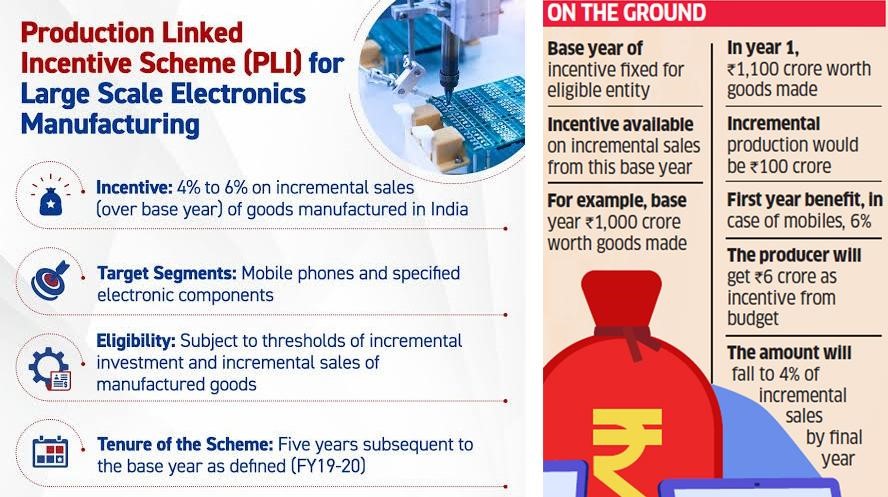
Copyright infringement is disclaimed
Automotive Mission Plan
- Automotive Mission Plan 2016-26 is a mutual initiative by the Government of India and the Indian automotive industry to lay down the roadmap for the development of the industry.
FAME Scheme
- FAME Scheme was extended for a further period of 2 years up to March 31st, 2024.
Conclusion
- India could be a leader in shared mobility by 2030, providing opportunities for electric and autonomous vehicles.
- The government is making a policy shift to electric vehicles to reduce emissions.
- The Government of India expects the automobile sector to attract US$ 8-10 billion in local and foreign investments by 2023.
- India could be a leader in shared mobility by 2030, providing opportunities for electric and autonomous vehicles.
Extension of RoDTEP Scheme for Export Sectors
Context
The union government extended the scope of benefits under the Remission of Duties and Taxes on Exported Products (RoDTEP) Scheme to companies functioning in Special Economic Zones (SEZ) as well as those in Advance Authorisation (AA) holders and Export Oriented Units (EOU).
RoDTEP Scheme
- The RoDTEP scheme was originally launched in 2021, and its benefits were initially applicable until September 30, 2023. The government has now extended these benefits until June 30, 2024, for existing export items, maintaining the same rates.
- RoDTEP scheme endeavours to boost exports and enhance the competitiveness of Indian products in the global market.
- The RoDTEP scheme replaced the Merchandise Exports from India Scheme (MEIS).
- The RoDTEP scheme aims to refund exporters for central, state, and local duties or taxes that were previously not refunded. This helps Indian exports become more competitive globally
|
RoDTEP does not include all exports. Exports under certain categories are currently excluded from RoDTEP benefits and that includes products exported from SEZs, EOUs, Electronic Hardware Technology Parks (EHTP), Biotechnology Parks (BTP), and Customs bonded warehouses; exports under Advance Authorisation (which allows duty-free imports of inputs for export production); re-exported imported goods.
|
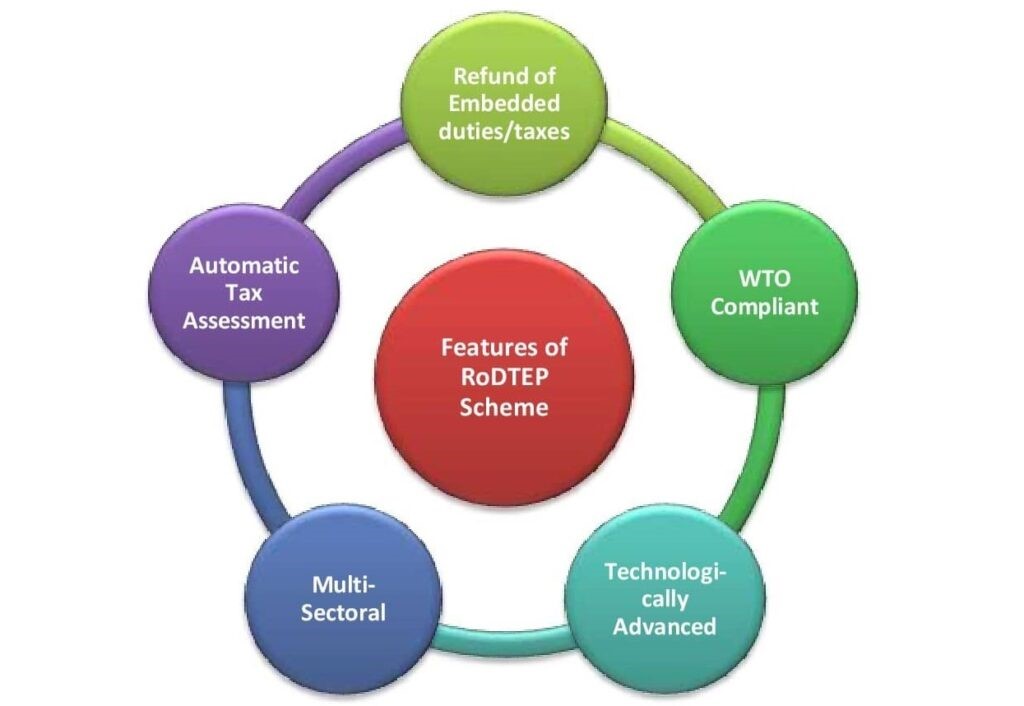
Objective
- The primary goal of RoDTEP is to refund taxes and duties that are not rebated under any other scheme.
- This includes various central, state, and local duties/taxes/levies that are incurred in the process of manufacturing and distribution of exported products but are not refunded through schemes like GST (Goods and Services Tax) or Duty Drawback scheme.
Key Points
- The government decision comes in recognition of the significant contribution these sectors make to India’s Exports, constituting approximately 25 per cent of our exports.
- Amidst global economic uncertainties and supply chain disruptions, extending RoDTEP to the uncovered sectors such as AA, EOU, and SEZ units will help the exporting community in handling the international headwinds.
Significance of the RoDTEP Scheme
Enhancing Competitiveness: By reimbursing various taxes such as those on power charges, Value-Added Tax (VAT) on fuel in transportation, and taxes related to the farm sector, the RoDTEP scheme makes Indian products more competitive in the global market.
Par with International Standards: The scheme allows Indian exporters to meet international standards for exports. Affordable testing and certification will be made available domestically, reducing the reliance on international organizations.
Automated Tax Assessment: Under the RoDTEP scheme, tax assessment becomes fully automatic for exporters. Businesses gain access to their Goods and Services Tax (GST) refunds through an automatic refund route, streamlining the process and improving ease of doing business.
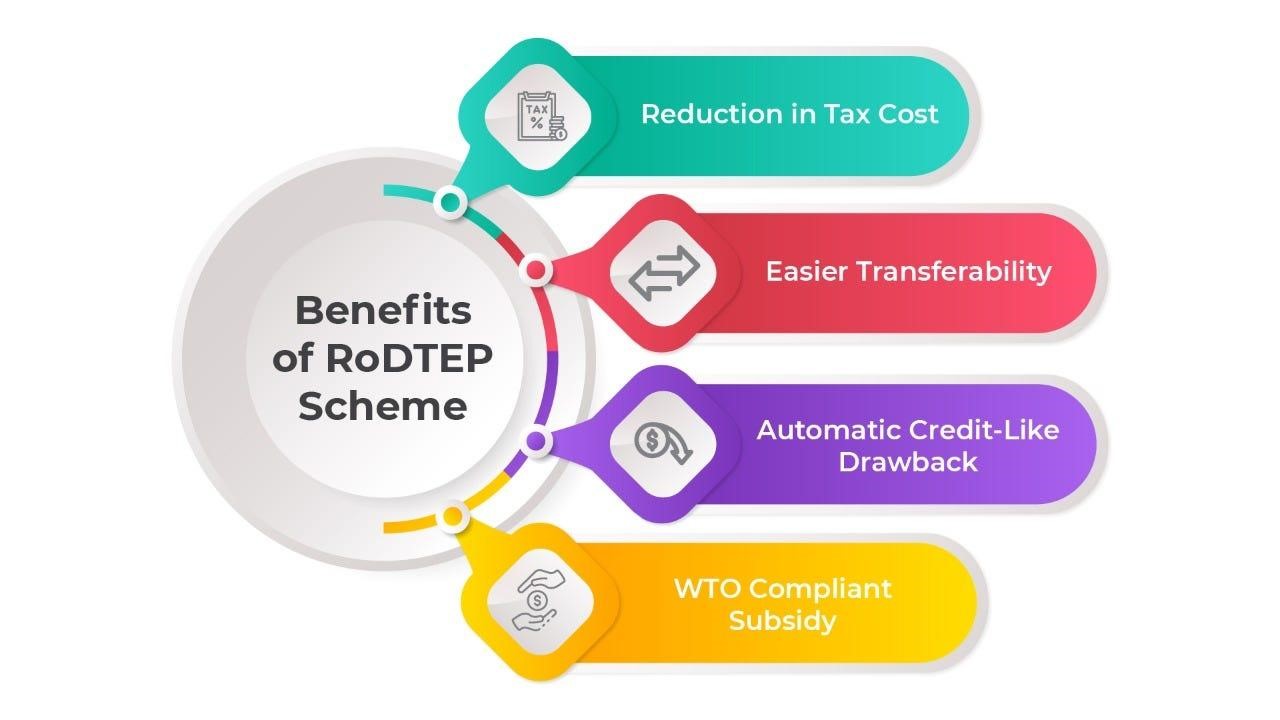
Way forward
- The RoDTEP scheme is aimed at boosting India's exports by reducing the tax and duty burden on exporters and making Indian goods more competitive in international markets.
- This effort aligns with the vision of fostering an Aatmanirbhar Bharat and is part of a larger strategy, including the negotiation of new free trade agreements (FTAs), aimed at propelling India towards a $1 trillion merchandise export target.
Agriculture Integrated Command and Control Centre
Context
Union Minister of Agriculture and Farmers’ Welfare inaugurated the Agriculture Integrated Command and Control Centre to empower the farmers of the country by equipping them with information, services and facilities.
Objective
- The initiative is a testament to the innovative approach of the Ministry of Agriculture and Farmers’ Welfare.
- The new initiative aims to provide farmers the information about the reality of the farm and also to find out what the real challenges our agriculture sector is facing.
- The primary objective is to foster self-reliance among farmers across the country.
- The centre can help resolve farmers’ problems by analyzing real-time data.
- It will also help to expand farmers’ capacity, and improve crop yields, ultimately benefiting the country’s agriculture sector.
- The farmers will also be able to avail the benefits of the government schemes.
Information Technology in Agriculture Sector
- Information technologies are finding increasing use in the agricultural value system, and farmers are increasingly becoming more informed.
- The Government has taken various measures to provide access to technology and information across the country, through various Digital Initiatives, such as:
National e-Governance Plan in Agriculture (NeGP-A): wherein, funds are provided to the State(s)/UT(s) for project involving use of modern technologies viz. Artificial Intelligence (AI), Machine Learning (ML), Robotics, Drones, Data Analytics, Block Chain etc. After receiving proposals from the States, funds are released for development of various solutions.
Digital Public Infrastructure: The Government has announced for development of Digital Public Infrastructure (DPI) for agriculture as an open source, open standard and inter-operable public good to enable inclusive farmer centric solutions through relevant information services for crop planning and health, improved access to farm inputs, credit and insurance, help for crop estimation, market intelligence etc. To generate crop sown registry, Digital crop survey has been launched on pilot basis in 12 states from Kharif 2023.
National Agriculture Market (e-NAM): It is a pan-India electronic trading portal which networks the existing Agricultural Produce Market Committee (APMC) mandis to create a unified national market for agricultural commodities. Digital services are provided to traders, farmers, Farmers Producer Organizations (FPO), Mandis through various modules of e-NAM platform such as FPO trading module, warehouse based trading module.
Integrated Scheme for Agricultural Marketing schemes (AGMARKNET): It aims to promote creation of agricultural marketing infrastructure by providing backend subsidy support to State, cooperative and private sector investments Services are provided through (AGMARKNET) portal which is a G2C e-governance portal that caters to the needs of various stakeholders such as farmers, industry, policy makers and academic institutions by providing agricultural marketing related information from a single window.
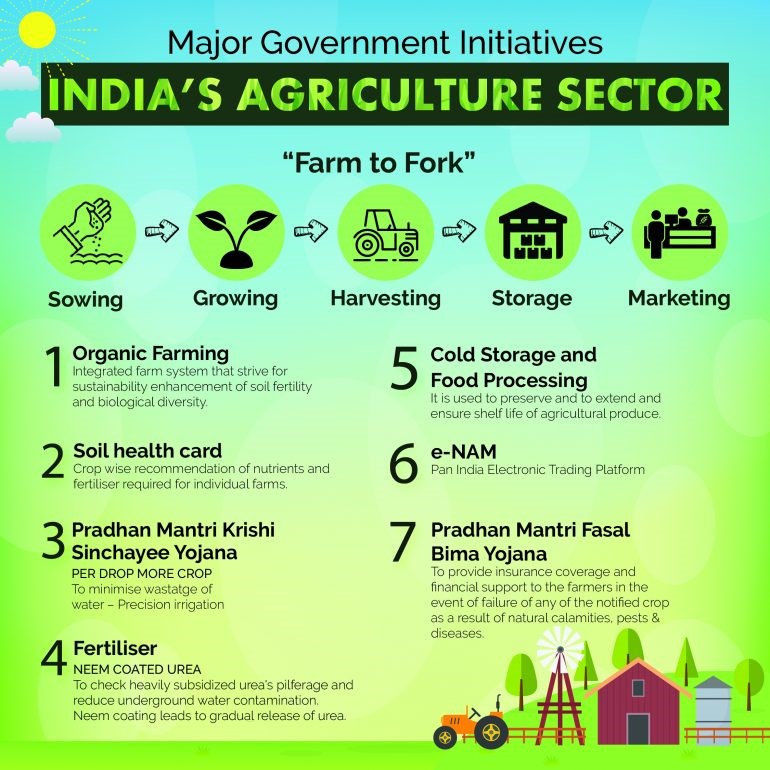
Copyright infringement is disclaimed
Way forward
- The Agriculture Integrated Command and Command Centre, it will be possible to see all the digital innovations being made in the agriculture sector by the Ministry of Agriculture and Farmers’ Welfare on a big screen simultaneously in one place.
- Additionally, the government has also set up an online portal for the entire process execution and visibility, encouraging more investments for the agriculture sector.
- In the coming years, the government plans to leverage technology to improve crop outcomes for farmers with better technology solutions.











